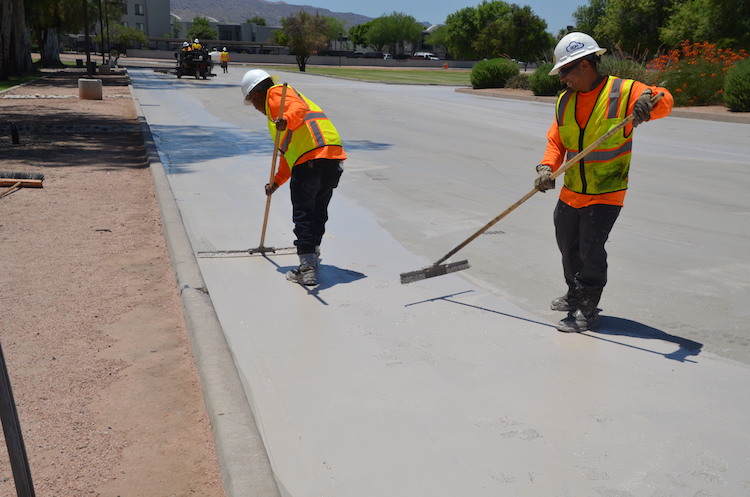- Home
- The Feature
- Phoenix Shares Results from First Year of Cool Pavement Study

Phoenix Shares Results from First Year of Cool Pavement Study
The City of Phoenix Street Transportation Department and Office of Sustainability announced during a virtual presentation and panel discussion on September 14 the results of the first year of its Cool Pavement Pilot Program. The program and analysis of the cool pavement process is being conducted in partnership with Arizona State University (ASU).
Year one of the study done by scientists at ASU’s Global Institute of Sustainability and Innovation, Healthy Urban Environments, and the Urban Climate Research Center revealed that reflective pavement surface temperatures are considerably lower than traditional roadway pavement.
“This is exactly what we were hoping for,” Phoenix Mayor Kate Gallego said. “The results are promising. While there’s more work to be done, it’s exciting to see a technology that has the potential to meet the demands of a growing desert city in a world where temperatures are constantly climbing.”
Cool pavement coating reflects a higher portion of the sunlight that hits it, hence absorbing less heat. Because of this higher reflection, the coating has the potential to offset rising nighttime temperatures in the region.
In 2020, the city selected portions of eight neighborhoods, one in each City Council district and part of the parking lot in Esteban Park, to receive cool pavement treatment. The asphalt coating was applied to areas already in need of pavement preservation. The city then partnered with ASU researchers to conduct scientific tests of the cool paved areas, studying how it performed and how it might be used to mitigate the urban heat island effect.
Findings from year one of the study include:
- Cool pavement revealed lower surface temperatures at all times of the day versus traditional asphalt.
- Cool pavement had an average surface temperature 10.5 to 12 degrees Fahrenheit lower than traditional asphalt at noon and during the afternoon hours. Surface temperatures at sunrise averaged 2.4 degrees Fahrenheit lower.
- Sub-surface temperatures averaged 4.8 degrees Fahrenheit lower in areas treated with cool pavement.
- Nighttime air temperature at six feet of height was on average 0.5 degrees Fahrenheit lower over cool pavement than on the non-treated surfaces.
- The human experience of heat exposure at noon and the afternoon hours was 5.5 degrees Fahrenheit higher due to surface reflectivity, but similar to walking on a typical concrete sidewalk.
- Surface solar reflectivity declined over 10 months from a range of 33 to 38 percent to a range of 19 to 30 percent across all eight neighborhoods. Untreated asphalt has a reflectivity of only 12 percent.
“This project is an excellent example of innovation and collaboration,” Street Transportation Department Director Kini Knudson said. “City staff innovated a spray-application method that greatly reduced time and labor costs, and then collaborated with ASU to use applied science to study its effectiveness. While we continue to study the initial cool pavement installations, we will soon begin a second phase of testing using a darker material that has been engineered to have an even higher surface reflectivity.”
Scientific data collection during year one of the study included thermal imaging through helicopter flyovers, temperature sensors embedded in the pavement surface, and other advanced instruments to conduct testing across various heat metrics. ASU researchers also developed MaRTy (derived from ‘Mean Radiant Temperature’), a specially designed mobile weather station that evaluates the human experience of heat by measuring 3D mean radiant temperature, air temperature, relative humidity, and wind speed and direction. Additionally, a vehicle equipped with air and surface temperature sensors traveled over the treated areas to gather data during four times of the day.
Asphalt collects and retains heat during the day and releases it at night. Phoenix is among several cities that are experiencing the urban heat island effect, particularly overnight, due to the retention of heat within the built environment. Higher nighttime temperatures lead to more energy consumption, more greenhouse gas emissions, air pollution and other harmful effects.
Read the Executive Summary of ASU’s scientific study (PDF)
To learn more about cool pavement and the next phases of the program, visit Phoenix.gov/Streets/CoolPavement.
